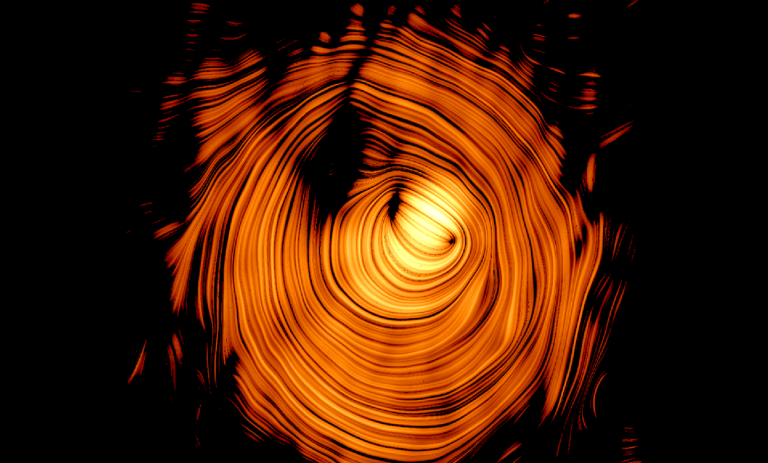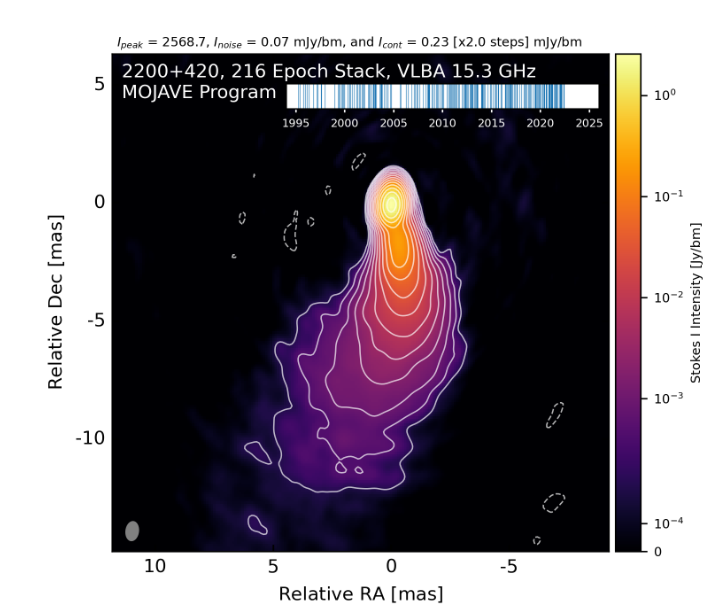
A group of scientists from different countries found something that will help explain how a distant and seemingly slow object in space, called PKS 1424+240, can be one of the brightest sources of very energetic light (gamma rays) and tiny particles called neutrinos. Even though it appears to move slowly, it produces a lot of these powerful signals.
It’s incredibly far away, at a redshift of 0.605, with a supermassive black hole at its center that’s constantly devouring matter.
Redshift is a form of measurement, which tells us how far away an object is and how fast it’s moving away. When a galaxy or blazar moves away, its light stretches toward the red end of the spectrum. A higher redshift means it’s farther and receding faster. PKS 1424+240 has a redshift of 0.605, which means, it’s billions of light-years away and we’re seeing light that left it when the universe was much younger.
When a Jet Looks Slow but Shines Bright
Interestingly, the radio jet of this blazar looked surprisingly slow when observed with VLBI (Very Long Baseline Interferometry), even though it was incredibly bright in gamma-rays. VLBI, links multiple radio telescopes across Earth to act like one giant telescope, all these together allows astronomers to see fine details in things like black hole jets and distant galaxies.
Normally, the brightness in these high-energy emissions is associated with how fast the jet is moving. Faster jets boost the light more due to a relativistic effect called Doppler boosting. So if the jet looks slow, we wouldn’t expect it to shine this intensely in gamma-rays. And this mismatch between the slow apparent motion in radio and the high brightness in gamma-rays is what scientists call the Doppler factor crisis. It’s like seeing a car in the distance that looks like it’s crawling along the road, but somehow its headlights are blindingly bright. Something didn’t add up, and it puzzled astronomers for years.
How the ‘Eye of Sauron’ Solved the Blazar’s Doppler Mystery
The breakthrough came when researchers looked at 15 years of radio observations from the VLBA at 15 GHz. They stacked 42 images taken between 2009 and 2025, which revealed the jet in remarkable detail. The resulting image was so striking it got nicknamed the “Eye of Sauron,” because it looked just like the eye from The Lord of the Rings.
On further investigation, the team discovered that the jet is pointing almost directly at Earth, with a viewing angle of less than 0.6 degrees. This head-on view explains why the jet looks slow in radio images, which also means, the apparent sluggish motion is just an illusion caused by perspective.
Also, the recorded angle makes the gamma-rays and neutrinos appear much brighter, due to strong Doppler boosting.
The Doppler factor here reaches about 30-32, that is almost three times higher than what is typical for jets in the MOJAVE sample. The MOJAVE sample is a collection of active galactic nuclei, mostly blazars, that astronomers monitor with the VLBA at radio wavelengths.
This suggests that the Doppler factor crisis wasn’t really a mystery, it was just a matter of how we were looking at it.

Blazar’s ‘Donut’ Magnetic Field Turns It Into a Particle Accelerator
Now there is another interesting part of the discovery – the magnetic field in the jet of the blazar is shaped like a doughnut or ring, called a toroidal magnetic field. This kind of field has a spiral or helix shape and means that electric current flows in the jet. This magnetic structure helps control the movement of charged particles (plasma) in the jet and likely helps speed up these particles to very high energies. Because of this process, the blazar acts like a natural particle accelerator, creating protons that can produce tiny, fast-moving particles called neutrinos with very high energy.
It’s like saying a garden hose with water flowing through it in a spiral, shaped like a donut tube (a torus). The water’s flow magnetic field is like a helical pattern, guiding the water smoothly along its path. Inside this hose, tiny particles (like small pebbles) are sped up by the swirling water, eventually reaching very high speeds. When these high-speed particles hit other particles or obstacles, they produce tiny, invisible particles called neutrinos that escape and travel through space.
Takeaway
Seeing a jet almost straight on is very uncommon. Simulations show that only a small number of these jets are aligned this way with Earth. Looking at the blazar PKS 1424+240 helps scientists understand what’s happening inside it, especially how the jet is angled, the magnetic fields involved, and the high-energy light it gives off.
PKS 1424+240 is a good example of how the way we see something depends on the angle we’re looking from. When we look at it from a small angle, its jet appears much brighter and more impressive, like a giant lighthouse in space that keeps shining in very energetic light called gamma rays and particles called neutrinos. This shows that by carefully observing objects over a long time, scientists can figure out things that seem very confusing or hard to understand at first.
Looking at more examples of these jets can help us understand where very energetic particles from space originate. It also helps improve our ideas about how black holes produce and control these jets. Sometimes, changing the way we look at things can help us see the complete picture of what’s happening in the universe.
Source: European Research Council



